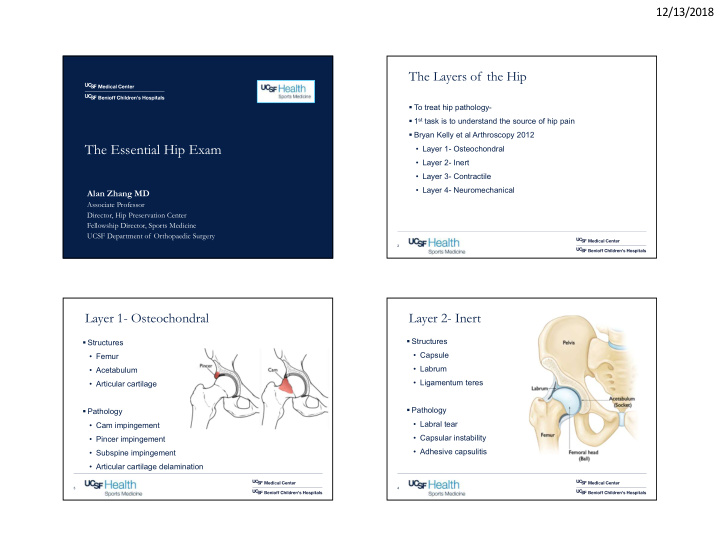



12/13/2018 The Layers of the Hip To treat hip pathology- 1 st task is to understand the source of hip pain Bryan Kelly et al Arthroscopy 2012 The Essential Hip Exam • Layer 1- Osteochondral • Layer 2- Inert • Layer 3- Contractile • Layer 4- Neuromechanical Alan Zhang MD Associate Professor Director, Hip Preservation Center Fellowship Director, Sports Medicine UCSF Department of Orthopaedic Surgery 2 Layer 1- Osteochondral Layer 2- Inert Structures Structures • Capsule • Femur • Labrum • Acetabulum • Ligamentum teres • Articular cartilage Pathology Pathology • Labral tear • Cam impingement • Capsular instability • Pincer impingement • Adhesive capsulitis • Subspine impingement • Articular cartilage delamination 3 4
12/13/2018 Layer 3- Contractile Layer 4- Neuromechanical Structures Structures • Muscles crossing hip • Neuro-vascular structures in • Pelvic floor hip region • Lumbosacral muscles • Regional mechanoreceptors Pathology Pathology • Gluteus medius tear • Pain syndromes • Hip flexor strain • Neuromuscular dysfunction • Proximal hamstring strain • Adductor tendinopathy 5 6 Location, Location, Location Physical Exam Anterior/groin • FAI Ambulation • Arthritis Supine exam • Flexor strain • ROM Lateral/thigh • Strength • Trochanteric pathology • Provocative/special maneuvers • Snapping hip Lateral Exam Buttock/posterior Prone Exam • Low back/sciatic nerve • Hamstring injury • Referred pain 7
12/13/2018 Trendelenberg Ambulation Gait Asses gait pattern • Antalgic gait ‒ Arthritis/acute injury • Trendelenberg gait/Single leg stance ‒ Trochanteric pathology ‒ Gluteus tear • FAI gait ‒ Loss of peak hip extension FAI gait Supine Exam ROM FAI gait Strength testing • Loss of peak hip extension Provocative exams Zhang et al AJSM 2016 • Increased hip joint loading in FAI patients 12
12/13/2018 Strength/Muscle Exam Range of Motion Rectus—hip flexion against Flexion (0-130) resistance IR @ 90 degrees of Abductors—push out legs flexion (0-30) Adductors—pull in legs ER @ 90 (0-60) Abduction (0-60) Extension (0-20) Arthritis- decreased globally FAI- decreased IR and flexion Provocative Exams Log Roll Log roll Assess for FADIR intra-articular hip pathology FABER Labral stress test/ Scour test Straight leg raise Sports hernia exam SI Joint exam 15 16
12/13/2018 FADIR for FAI Flexion ADduction Internal Rotation FABER Test Flexion ABduction External Rotation SI pathology Sometimes anterior labral pathology
12/13/2018 Labral Testing/Scour Test Straight Leg Raise Hamstring tightness Radiating pain (lumbar radiculopathy) Sports Hernia (Athletic Pubalgia) Sports Hernia Exam Palpation • Pubic symphysis/Pubic tubercle Strain or tear of soft tissue in lower abdomen • Insertion of rectus (confluence of structures) or groin area • Adductor origin (AL, AB, pectineus) • Inguinal disruption • Superficial inguinal ring • Adductor injury ‒ Rule out true hernia • Abdominal wall injury ‒ Size of ring (dilation indicates weakened area) ‒ Check tenderness of posterior wall 23 24
12/13/2018 Sports Hernia Exam SI Joint Examinations Special maneuvers FABER Test • Resisted sit up (legs Distraction Test straight, 10-30 deg trunk flexion) Thigh Thrust Test • Adductor Squeeze test (0 Gaenslen Test deg and 90 deg of hip flexion) – pain/strength Compression Test • Valsalva Sacral Thrust Test 3 or more positive tests indicate SI joint dysfunction 25 26 Thigh Thrust Test Distraction Test Examiner will flex the hip and knee on injured side to “thrust” while patient pelvis is flat on table Examiner pushed outward and down on both iliac wings 27 28
12/13/2018 Gaenslen Test Compression Test Injured side in extension and off the table while uninjured side is Lay on side opposite of pain while examiner pushes down flexed 29 30 Sacral Thrust Test Lateral Exam Examiner Pushes down on Sacrum OBER test • IT band tightness Palpate Greater Trochanter • Trochanteric bursitis Gluteus Medius strength testing 31
12/13/2018 Ober Test Gluteus Medius Strength Test 33 34 Prone exam Thank You Hamstring exam • Palpate for defects • Evaluate for weakness 36
Recommend
More recommend